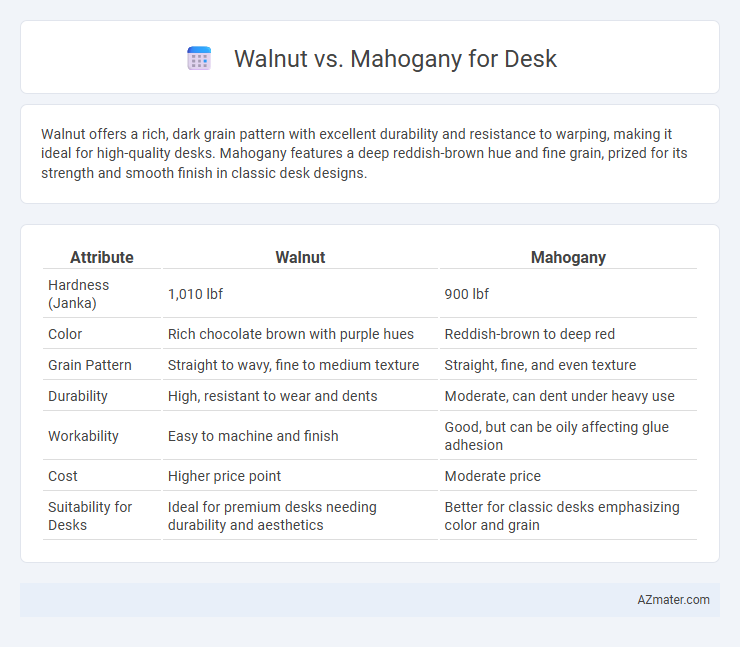Walnut offers a rich, dark grain pattern with excellent durability and resistance to warping, making it ideal for high-quality desks. Mahogany features a deep reddish-brown hue and fine grain, prized for its strength and smooth finish in classic desk designs.
Table of Comparison
| Attribute | Walnut | Mahogany |
|---|---|---|
| Hardness (Janka) | 1,010 lbf | 900 lbf |
| Color | Rich chocolate brown with purple hues | Reddish-brown to deep red |
| Grain Pattern | Straight to wavy, fine to medium texture | Straight, fine, and even texture |
| Durability | High, resistant to wear and dents | Moderate, can dent under heavy use |
| Workability | Easy to machine and finish | Good, but can be oily affecting glue adhesion |
| Cost | Higher price point | Moderate price |
| Suitability for Desks | Ideal for premium desks needing durability and aesthetics | Better for classic desks emphasizing color and grain |
Introduction to Walnut and Mahogany Desks
Walnut desks are renowned for their rich, warm tones and distinctive grain patterns that combine beauty with durability, making them a popular choice for high-quality office furniture. Mahogany desks feature a deep reddish-brown hue and fine, straight grain that exudes classic elegance and exceptional sturdiness, often favored in traditional or formal settings. Both hardwoods provide excellent strength and longevity, but walnut offers a modern appeal while mahogany reflects timeless sophistication.
Appearance and Grain Patterns
Walnut desks boast rich, warm tones ranging from chocolate brown to deep purples, featuring a fine, straight grain with occasional waves and curls that add character. Mahogany desks display a reddish-brown hue that darkens with age, showcasing a consistent, straight grain often interspersed with subtle, decorative figuring such as ribbon or interlocked patterns. Both woods offer luxurious aesthetics, but walnut's varied grain patterns create a more dynamic appearance compared to the smoother, uniform look of mahogany.
Durability and Strength Comparison
Walnut offers excellent durability with a Janka hardness rating of around 1,010, making it resistant to dents and scratches, while Mahogany typically scores slightly lower at approximately 900 but is known for its dense, stable grain structure. Both woods provide solid strength for desk construction, though Mahogany's natural resistance to warping and decay enhances long-term stability in varying environments. Choosing between the two depends on the balance between slightly higher hardness in Walnut and superior dimensional stability in Mahogany for a durable, strong desk.
Color and Finish Options
Walnut offers rich, warm tones ranging from light brown to deep chocolate, with a smooth grain that enhances its natural luster and takes finishes exceptionally well, often resulting in a satin or matte appearance. Mahogany features a reddish-brown hue that deepens over time, providing a luxurious and elegant finish with a fine, straight grain that polishes to a high gloss. Both woods accommodate a variety of finishes, but walnut's versatility suits modern and rustic styles, while mahogany's classic beauty is ideal for traditional and formal desk designs.
Workability and Craftsmanship
Walnut offers superior workability for desks due to its fine, straight grain and moderate hardness, allowing craftsmen to achieve intricate detailing and smooth finishes. Mahogany is prized for its durability and rich color, but its slightly coarser grain demands more careful handling during cutting and shaping. Both woods are favored for high-quality desks, with walnut providing easier machining and mahogany delivering robust strength and classic aesthetics.
Cost and Value Analysis
Walnut desks typically cost between $800 and $1,500, offering a rich, elegant grain and medium durability suitable for high-end furniture. Mahogany desks range from $1,200 to $2,000, providing exceptional strength, deep reddish hues, and resistance to wear, which justifies the higher price point. When evaluating value, walnut offers a balance of beauty and affordability, while mahogany provides superior longevity and premium aesthetics that appeal to luxury buyers.
Sustainability and Environmental Impact
Walnut and mahogany differ significantly in sustainability and environmental impact, with walnut often sourced from temperate forests managed for responsible harvesting, promoting ecological balance. Mahogany, especially from tropical rainforests, faces deforestation concerns and is frequently associated with illegal logging and habitat loss, raising environmental red flags. Choosing walnut furniture reduces ecological footprint due to better forest management practices and lower carbon emissions compared to mahogany's often unsustainable supply chain.
Maintenance and Longevity
Walnut desks require moderate maintenance, benefiting from regular dusting and occasional oiling to preserve their natural luster, while mahogany offers superior durability with a hard, dense grain that resists scratches and dents more effectively. Mahogany's longevity often surpasses walnut due to its resistance to moisture and warping, making it ideal for environments with fluctuating humidity. Both woods age gracefully, but mahogany's sturdiness ensures the desk remains structurally sound and visually appealing over many decades.
Best Uses for Walnut and Mahogany Desks
Walnut desks excel in providing a rich, warm aesthetic with a smooth grain, making them ideal for executive offices and contemporary home workspaces where elegance and durability are paramount. Mahogany desks offer exceptional stability and a deep reddish-brown hue, perfect for traditional or formal settings such as boardrooms and library desks that require a classic, luxurious appearance. Both woods resist wear well, but walnut's versatility suits modern designs, while mahogany's density makes it better for intricate carvings and heirloom-quality furniture.
Choosing the Right Wood for Your Desk
Walnut offers a rich, dark brown color with fine grain patterns, making it ideal for elegant, durable desks that age beautifully over time. Mahogany, known for its reddish-brown hue and straight grain, provides excellent stability and smooth finish, often preferred for traditional and formal desk designs. Considering factors like desired aesthetics, wood hardness, and budget helps determine whether walnut's luxury appeal or mahogany's classic warmth best suits your desk needs.

Infographic: Walnut vs Mahogany for Desk
 azmater.com
azmater.com